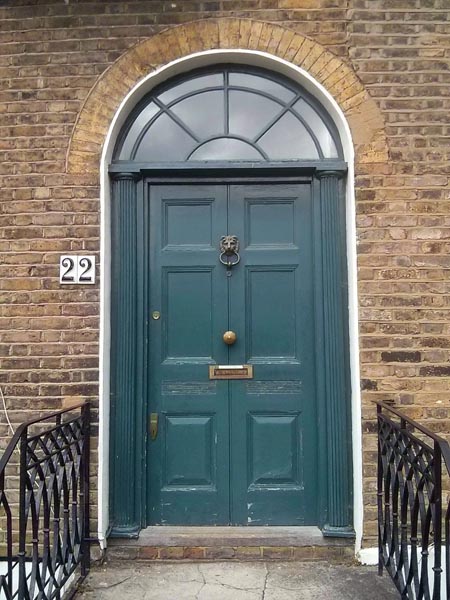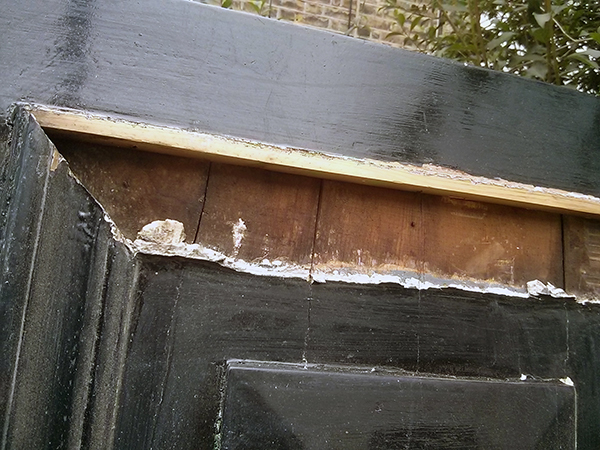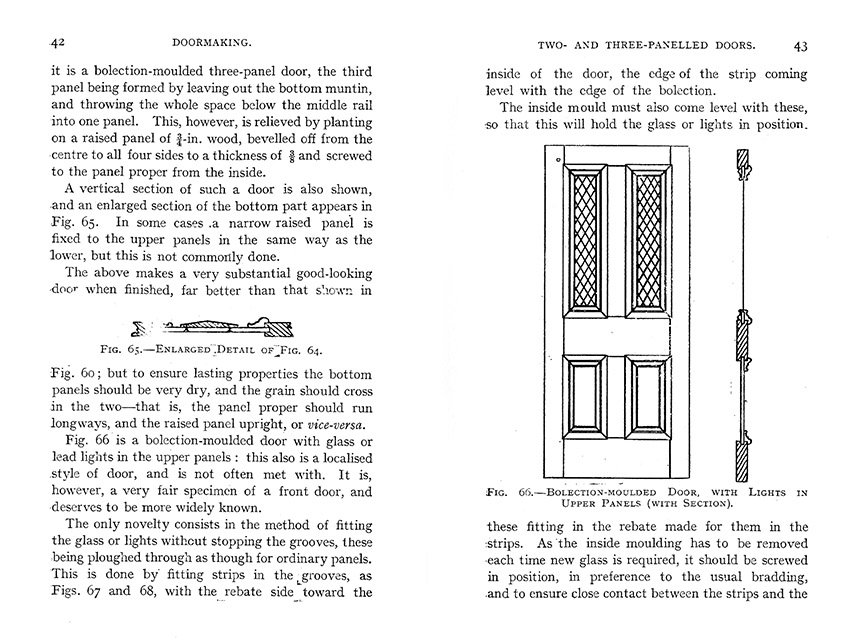
The wonderful Høvelbenk blog is rapidly becoming a favourite of mine. Having recently found a Stanley No.20 circular plane, I’m keen to see a few in action and learn a bit more about what it can do. The latest post on Høvelbenk seems to be concerned with the restoration of a curved moulded arch over a historic door. The blog is Swedish, and I dearly wish I could read it in English, but the pictures are, as ever, nicely shot and edited. One very interesting shot shows planes which the writers seem to make (!), as part of the project. Wonderful stuff. I really hope this post makes it into their English category.
Category: Practical techniques
A door examination

In our part of London there are some lovely examples of Georgian and Victorian houses. The area around Brick Lane is well documented now, but if you are a visitor and you are interested in architecture, you might take a wander up Brick Lane and duck into the Spitalfields area. Streets such as Fournier St and Fashion St have some fine old houses that have been renovated with a lot of care by their owners. (You can read a lot more about this on the Spitalfields Life blog. In particular, I thought this post was lovely.

Up towards my stomping ground on the eastern side of Hackney, the houses are a little less grand, but areas such as Clapton Square have some lovely Georgian houses too. (The above pic is a nice door from a typical house on the square.)
Whilst walking around the local streets the other day I noticed some tradesman replacing a door and the old door was still on the street. I was interested to see the building-up of the moulded sections. The deep outer moulding on the main lower panel is rebated back, to hang over the square edge. I’m used to seeing that, and it’s good practice, allowing for shrinkage. It was interesting to see the thinner panels that must have been jointed and glued up to make a larger flat panel to act as the ‘core’ of the panel. I suppose it makes sense in terms of material that was available back then and the fact most of it was subsequently covered by the raised panel and outer mouldings.


After a browse through the LAP book ‘Doormaking & Windowmaking’, I found reference to these sorts of doors, the construction of which is actually quite interesting. I especially like the technique of cutting the rebate for the bolection bolding as a very slight wedge shape. When you nail the bolection in, the shallow angle forces the outs flanges of the moulding to pull in very tightly, important especially as the upper edges are exposed to the running-off of water from the door.
(Click the pics to get a readable size.)




Home made shooting jig
Another craftsman-made design from Colin Sullivan, this time a nice modification that makes a standard S/S plane into a much more useable shooting plane, much like the Record T5, but perhaps with a better handle. Colin writes:
The main weakness with an ordinary shoot board is the way the plane can easily be tipped over and spoil the stop. To overcome this I have given the plane a sliding track section it fits into. Now the plane can be pulled and pushed with out the need to hold it up against the work. The sliding section is 3mm thick ply profiled to fit the plane and fixed to another piece of the same ply underneath. The lower piece of ply runs in two guides. The plane I use is a no.6.5 which is quite heavy giving the momentum required. To make things easier I have added a vertical handle to the plane, which is simply attached by a peg that fits in the curve of the plane handle. Another refinement would be to make the guide runner thick enough to take a couple of thin magnets to hold down the plane even more securely. This jig is not only simple to make but easy to use and more reliable than the normal one. The Tools and Trades History Society has a wonderful tool Museum at Amberley Museum and Heritage Centre where I can demonstrate various tools and jigs I have made. I have a working drawing of this jig I will pass onto any one who wants to make one.



Home Made Tools

I’ve bought and sold hundreds and hundreds of vintage woodworking tools over the years (my shop will be online very soon, just sorting out Paypal integration), and I’ve seen many craftsman-made tools in that time. Most usually they are made by pattern makers who perhaps didn’t want to pay good money for a tool they could make themselves, or sometimes they are just made by a craftsman who wants the challenge of making the tool as good as the original.
Colin Sullivan got in touch with me and sent these pictures over. I’m keen to see more examples of tools made by individuals. The work on this particular plane is as good as any I’ve seen.
Copy and words below from Colin Sullivan
I have been interested in Mitre planes and bevel up planes for years and when I injured my left hand index finger I was worried I would not be able to make things. During the few days I had off from work I decided to start making the plane shown.
It is exactly the same size as a Stanley no9 block plane with a few of my own ideas added including S/Steel. The blade angle is 22 deg. with the bevel up as the no9. The cap iron is from a Stanley no.4 transitional plane – because it is a bit longer than a normal one and almost the length of the no.9. The front infill knob is screwed to the adjustable part of the sole to allow a little adjustment to the mouth. The blade adjustment is controlled by turning the rear knob which works well. This proved so sucessful that I felt I could make a more accurate copy of the no9, and this is shown in the 3 pictures below.
I made this copy of a Stanley no.9 Cabinet makers Block Plane a few years ago. A friend had an original one that I carefully dimensioned and made a working drawing. I am a collector of American Stanley tools and this plane is top of my list for desirability, but because they fetch so much in auctions I decided the only way I would get one was to make it! When I was in business making spiral stairs we used stainless steel a lot on balustrades and stringers etc. It is the perfect material for making some tools because there is no chance of it rusting, it is not as difficult to work as people make out if you approach in the right way.
I cut out all the parts for this plane with the angle grinder using the new very thin cutting blades, you can buy-they are amazingly efficient and only 1mm or so thick. The box part is made up from 3mm s/s plate- welded together round a wooden block and cleaned up with the angle grinder and 120 grit soft discs. The cap iron is made from 10mm plate and is not bent but straight- tapered of at one end and longer than the standard ones. The blade is 3mm thick form Clifton Tools and holds an edge well, the mouth is adjustable and in fact made that part of the plane easier to make. The adjusting wheel I turned on my old lathe using a 8mm Allen grub screw for the thread which is right hand on these planes. The blade adjusting lever is the most difficult bit to make and get working properly.
The bracket that houses the adjuster and rosewood handle is made from angle s/s with a plate welded to it where it meets the plane, just the same as the Stanley. The polished finish was done with flap wheels in the pillar drill after the angle grinder, and the sole lapped on plate glass with fine sand, from a children’s toy I seem to remember. The bolts are all Allen type because it is a new tool and I have not tried to pretend other wise. It works very well and well worth the time it took to make much admired by every one I show.
I do have the drawings still if any one fancies having a go I can pass them on. This was my first attempt at making a low angle block plane in S/S, it works well.If you would like to contact Colin with questions about his planes, or if you would like to get drawings, please mail colinsllvn@btopenworld.com
On Geometry

Today’s woodworker has a lot more help when it comes to working out the tricky angles of some furniture joints, roof geometry or the wind and rise of a set of stairs he is constructing. Back in the day, school geometry lessons fed straight into the knowledge needed in an apprenticeship and carpenters found themselves learning on the job and learning what was needed to be able to draft calculations in their heads.
A lot of this knowledge has been lost as technology has taken over somewhat, but I find myself increasingly fascinated in the various calculations one can learn to estimate precise cutting angles.
Following on from my post about French ‘guitardes’ and ‘L’art du Trait‘, I have been researching knowledge about plane geometry and it’s use in carpentry and joinery.
Over on ‘A Woodworker’s Musings’, D.B.Blaney not only seems to know a lot more about this in practice than me, but has also constructed some fine models. I love the pictures of loftsmen in the mould loft at Harland and Wolff shipyards. You can see the large drawings on the floor from the loftsmen.
I contacted Mr Blaney about this great post and asked if he had some reference on how to get re-aquainted with plane geometry and it’s use. He recommended some books:
A Treatise on Stairbuilding and Handrailing by W & A Mowat
A Builder’s Companion by Asher Benjamin
Basic Perspective Drawing by John Montague
and also Chris Hall’s website, The Carpentry Way.
(I have also been told a recent book called A Simplified Guide to Custom Stairbuilding and Tangent Handrailing by George Di Cristina is also excellent)
This brought me onto Googling tangent stairbuilding and I hit upon a four-part series online by ThisIsCarpentry, which explains how geometry is used in tangent handrailing and crafting a proper volute.
Tangent Handrailing
Drawing a volute
Carving a volute
I’m sure there’s a lot more out there, any recommendations for making a start are gratefully received. I did also buy the new book from Lost Art Press, ‘By Hand & Eye‘, but overall I didn’t think it was put together very well, or was that helpful. I believe the authors are currently making an accompanying ‘workbook’ to explain the workings better. Read into that what you will, but not one of LAP’s better books, in my opinion.



